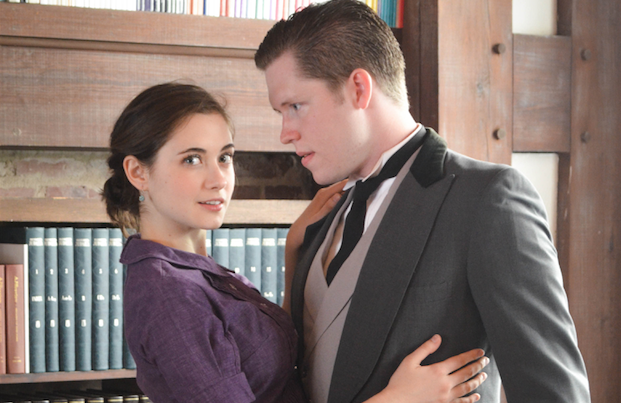With our long national election nightmare over, and an even longer reign of terror about to begin, I'm tempted to find a TARDIS and teleport myself a continent or a century away from Florida 2016. But if you imagine that post-Edwardian England, setting of a certain celebrated PBS soap opera, would be a safe place to escape raging political debates over gender roles, health care and workers' rights, Upton Abbey: An Improvised Comedy of English Manors will disabuse you of that notion.
The full-length extemporized production currently playing Rollins College's Annie Russell Theatre is packed with humor that will appeal to Downton devotees. But as creator-director David Charles shared prior to a dress rehearsal, he knew long before last week's historic election that the still-relevant issues underlying the show's World War I setting deserved some deep-dive dramaturgy. "The idea germinated at the end of last year. We're always looking for shows that can feature our incredibly talented women, and we were looking at a season about the election process and what it is to be a citizen. It's also looking at the role of women, an increasing understanding of sexuality, and class warfare – all things that we might be fighting for again."
That's why Charles assembled a team of 12 students who spent the summer not just watching episodes of Julian Fellowes' series, but delving into the rapidly changing foods, fashions and faiths of early-20th-century British nobility. Grace Zottig, a researcher and stage manager, said they used the biography of Lady Almina Carnarvon, fifth countess of Highclere Castle (filming location of Downton Abbey) as a foundation, and used her life to inspire some of the characters. They supplemented that with other references mostly found in "actual books," as opposed to online searches, that informed the characters' backstories.
The choice of the year 1918 (coinciding with Season 2 of Downton Abbey) as a setting was equally deliberate. "It's at the height of the war," Charles explains. "The trench atrocities had become widely known at that point ... meanwhile, we sit on this beautiful estate. There's a juxtaposition that gives us opportunities for comedy, but we try not to be too shy about digging into some of the deeper issues at play as well."
All this would be rich enough material for a scripted plot, but weaving it into one that is improvised on the spot during every performance – with audience members picking plot points and featured characters through internet voting pre-show and during intermission – sounds nigh impossible.
"We're all taking a leap of faith," Charles admits, calling the production an "experiment." The research helps keep the ad libs from going off the rails: "These characters are really fleshed out. ... There's a structure that helps us, but it's like a skeleton."
Charles' company is able to rise to the challenge with the help of training provided by his Rollins Improv Players, a 13-year-old troupe that performs 30 to 35 times per year. Under his direction, Charles says the college has earned a reputation for educating improvisers. "I was just at an international conference talking about this kind of work, one of a few people invited. It's certainly unique." The backstage technicians must be as sharp as the actors onstage, using a secret system to stay one step ahead of the story and prepare scene changes that unfold effortlessly on each impromptu punchline.
Speaking for all the technical disciplines, Charles says he thinks "they both dread and are tickled by these improv shows, because they know it's not business as usual." With 15 "upstairs" characters and 15 "downstairs" characters, and each actor playing one of each and changing between them on the fly, first-time mainstage costume designer Katie Stine faced daunting questions like, "How am I going to get someone from a wheelchair-bound man to a soldier fighting on the front lines in 45 seconds?"
Thirty period costumes could break any budget; luckily Rollins' costume shop supplied a surplus of not-quite-right remnants as raw materials that Stine repurposed: "I call it a Cinderella story. I take costumes that are similar to what I'm looking for, and completely rework them, which tends to be cheaper." A favorite piece is a beaded pink evening dress that used to be a "ridiculous" 1960s cocktail dress.
As if Upton Abbey weren't ambitious enough already, the story will also progress serially from one performance to the next, with decisions made in earlier episodes impacting the finale. "If you come opening [night], and come again for the seventh show, you're not going to be lost," Charles concludes. "The hope is that we can appeal both to the one-time viewer who's just dipping in for a visit, but also by show eight this world is going to be different; characters are going to be changed, secrets will upend relationships." The rehearsal act I observed left me impressed, so if you're still missing the Grantham family's antics, make arrangements to see Upton Abbey now; you can't binge-watch this one on Netflix at your leisure.


